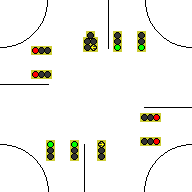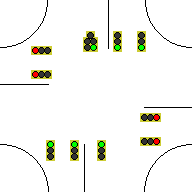FLASHING YELLOW ARROW
INSERTED ALL-RED CLEAR

Signal display sequence
(slow animation to show clearance periods)
The Flashing Yellow Arrows method prevents yellow-trap by extending the period of the permissive turn until the lagging left-turn phase terminates. Thus, the permissive turn ends at the same time as the oncoming straight-ahead movement. A flashing yellow arrow keeps the adjacent straight-ahead movement (which has a red light) from falsely moving during this interval.

Signal phase order
(fast animation)

Signal display sequence
(slow animation to show clearance periods)
The Inserted Red Clearance method prevents yellow-trap by forcing the oncoming straight-ahead phase to terminate at the same time the oncoming permissive turn terminates. After a short all-red clearance to allow all left turns already waiting in the intersection to clear, the lagging turn phase and its concurrent straight-ahead movement are shown their green signals.

Signal phase order
(fast animation)
The basic Flashing Yellow Arrow method:
- Special signal faces are used for left-turn displays (see below).
- All heads with both permissive and protected left turns, plus all left-turn heads for oncoming traffic having permissive left turns, must have special signal faces.
- The basic flashing-arrow signal head displays the same aspects as the oncoming straight-ahead signals, unless a left turn phase for those turning drivers replaces the permissive display.
- The wiring for this system requires special lamp driver circuitry to flash the yellow arrow and darken the permissive display when the protected phase is active. Signal installations will also need extra lamp circuits per span wire or mast arm, since there are more signal indications facing in each direction.
- The change in the MUTCD (Manual of Uniform Traffic Control Devices) definition of a flashing yellow arrow was made in the 2009 MUTCD.
- A circular yellow is used to terminate the flashing yellow arrow, so it is quite evident that termination is taking place.
- Unlike the Dallas left turn, this method does not require screening the left turn signal head from adjacent straight-ahead traffic.
- This is the most promising solution to the problem.
The basic Inserted Red Clearance method:
- No special signal faces are needed.
- Special dummy phases are needed to make this work. This means that a standard 8-phase signal controller can not be used for a full quad split lead installation using this method.
- The signal display methods and wiring are the standard displays used in conventional installations.
- Special actuation circuits are needed for the dummy phases. Other wiring for this system is standard.
- A special phase sequence must be designed for every phase order this method is used for.
- No changes are needed in the MUTCD (Manual of Uniform Traffic Control Devices) for the method.
- Because the lagging through movement is interrupted, this is not a good yellow-trap solution for lead-lag phasing used for widening the progression-through-band at locations away from platoon crossing points.
Flashing Yellow Arrows sample installation data:
- The lagging left turn shown above as it would be installed.
- A visual example of flashing yellow arrows.
- Flashing Yellow Arrows in a quad split lead signal.
- Flashing Yellow Arrows in a quad single-split lead-lag signal.
- For comparison:
A standard quad split lead left-turn signal causing yellow-trap.
Flashing Yellow Arrows links:
Inserted Red Clear sample installation data:
CALL REDIRECTION
FALSE CALL INSERTION

Signal phase order
(fast animation)

Signal phase order
(fast animation)
The basic Call Redirection method:
- Standard signal faces are used for all displays.
- Detector calls to a left turn phase are redirected to the adjacent straight-ahead phase when the oncoming straight-ahead phase is active (displaying a green or yellow signal, or timing a red clearance).
- This prevents the left-turn phases from activating while both straight-ahead phases are active.
- Many signal controllers already have this feature, which is activated by setting bits in the PROM.
- No changes are needed in the MUTCD (Manual of Uniform Traffic Control Devices) for this method.
- This method will not work with any signal phasings other than leading left turns.
- Call Inhibit is similar to Call Redirection, except that the call is totally ignored, instead of being redirected. This can be used if the inhibited movement already has a circular green. But it removes dilemma-zone protection from the inhibited movement.
The basic False Call Insertion method:
- Standard signal faces are used for all displays.
- Detector calls to a left turn phase are also sent to the calling-detector input of any phase on the other street. This involves connecting a wire from the terminal where the left turn detector is connected to its own phase to the calling-detector input of a cross-street phase.
- This requires a cross-street phase to display before the left turn phase. If there are no active calls on the cross-street phase, it will use the minimum-green time and then terminate.
- No changes are needed in the MUTCD (Manual of Uniform Traffic Control Devices) for this method.
- This method will not work with any signal phasings other than leading left turns.
Call Redirection sample installation data:
- The leading left turn shown above as it would be installed.
- Call Redirection in a quad split lead signal.
- For comparison:
A standard quad split lead left-turn signal causing yellow-trap.







